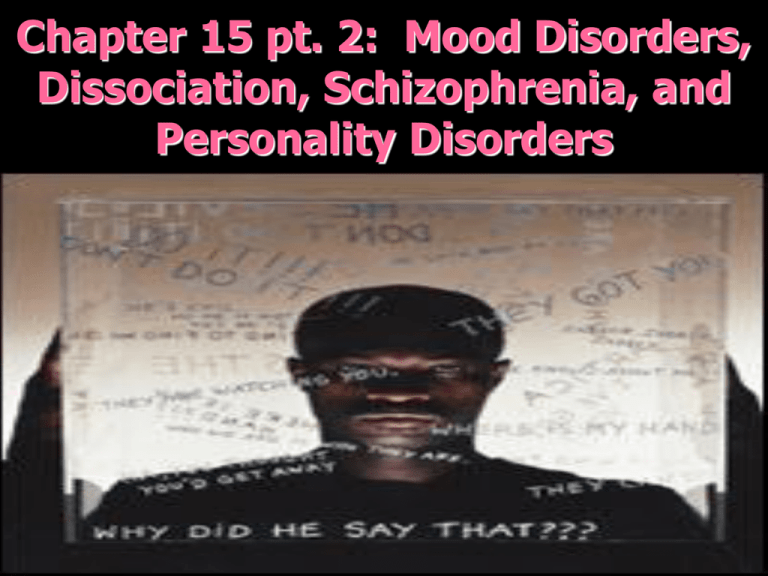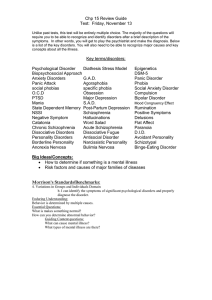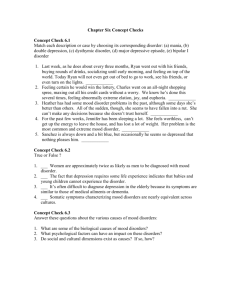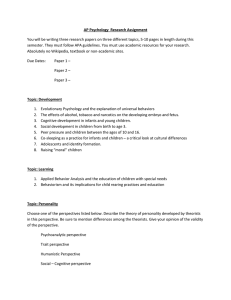Chapter 15 pt. 2: Mood Disorders, Dissociation, Schizophrenia, and Personality Disorders
advertisement

Chapter 15 pt. 2: Mood Disorders, Dissociation, Schizophrenia, and Personality Disorders Mood Disorders Illustrate Emotional Extremes Mood Disorders are characterized by emotional extremes and come in variety of forms: –1. Major Depressive Disorder –2. Dysthymic Disorder –3. Seasonal Affective Disorder –4. Bipolar Disorder Depression Is Pervasive Nearly everyone will experience at least some type of mild depression in their life often due to some external sad event. Major Depressive Disorder: differentiates itself from mild depression since a person has depressed mood, feelings of worthlessness, and diminished interest FOR NO EXTERNAL REASON for 2 or more weeks. . – Dysthymic Disorder: less severe down swing in mood but lasts for 2 or more years. Depression Seasonal Affective Disorder: also known as “winter depression.” Nearly unknown in the tropics, but measurably prevalent in higher latitudes especially in polar areas where daylight becomes rare in winter. Gender and Depression 25 Percentage of population aged 18-84 experiencing major depression at some point In life Around the world women are more susceptible to depression 20 20 15 15 10 10 5 5 0 0 USA Edmonton Puerto Rico Males Females Paris West Florence Beirut Germany Taiwan Korea New Zealand Gender and Depression 10% Percentage 8 depressed Females 6 4 2 0 Males 12-17 18-24 25-34 35-44 45-54 55-64 65-74 75+ Age in Years Effects on Depression Neurotransmitter, Brain chemistry Cognition Mood serotonin is scarce during depression. Cognitively, people tend to have a negative explanatory outlook which helps feed depression and lower mood. Vicious Cycle of Depression 1 Stressful Breaking experiences 4 Cognitive and 2 Negative behavioral changes explanatory style 3 Depressed mood any of the links can often help eliminate depression. Bipolar Disorder Bipolar Disorder: mood disorder in which person alternates between hopelessness and lethargy of depression and the overexcited, hyperactive, optimistic state of mania. Used to be known as Manic Depressive Disorder. – 1% VS. Mood Disorders and Suicide Suicides per 70 100,000 people 60 50 40 The higher suicide rate among men greatly increases in late adulthood 30 20 10 0 15-24 25-34 35-44 45-44 55-64 65-74 75-84 85+ Males Females Explaining Mood Disorders 1. 2. 3. 4. 5. 6. Many behavioral and cognitive changes accompany depression Unmotivated, grades decreases, no sleep……. Depression is widespread Women at greater risk Women more passive Men more active Depression usually goes away Stressful events usually precede depression Depression is striking more and earlier Explaining Mood Disorders Genetic –Mood disorders are genetic –Have not found a single “depression” gene The Brain –Decrease in serotonin –Lack of activity in frontal lobe In Dissociative Disorders general Dissociative Disorders are disorders in which a person’s conscious awareness becomes separated (dissociated) from previous memories and feelings. Dissociative Identity Disorder: used to be known as multiple personality disorder. Rare disorder where person exhibits 2 or more distinct and alternating personalities. Dissociative Disorders Include Amnesia (NOT IN BOOK) Unlike other forms of memory loss dissociative memory loss is NOT caused by brain trauma. Anterograde Amnesia: loss of memory after a traumatic event. Cant learn new facts that occur after incident. Retrograde Amnesia: loss of memories from before a traumatic event. Cant remember anything prior to the incident. Dissociative (Psychogenic) Amnesia: is the loss of a person’s identity. According to Freud, caused by intense anxiety. Serves as an escape. Dissociation Disorders (NOT IN BOOK) Dissociative (Psychogenic) Fugue State: when person with amnesia physically moves away from home and takes on a new identity somewhere else. Usually temporary and according to some researchers is caused by traumatic/stressful episode. Warm Up Identify the following disorders: 1. Seasonal Affective Disorder 2. Bipolar Disorder 3. Major Depressive Disorder 4. Dysthymic 5. Dissociative Identity 6. Dissociative Fugue 7. Dissociative Amnesia Schizophrenia Is Not One Disorder Schizophrenia is a group of disorders characterized by disorganized and delusional thinking, disturbed perceptions, and inappropriate emotions. Schizophrenics often experience hallucinations (false perceptions) and delusions (false beliefs of grandeur or persecution). Background 1 in 100 ppl get it Typically appears in teens and twenties – Men before 25 – Women 25-45 Men and women affected equally http://www.youtube.c om/watch?v=Qzd1KE siQVI http://www.youtube.c om/results?search_qu ery=+schizophrenia http://www.youtube.c om/watch?v=7s_gFm-7Ao Positive vs. Negative Symptoms Positive symptoms involve the presence of inappropriate perceptions behavior. –Ex: Hallucinations, Delusions, “Word Salad,” Inappropriate laughter, etc. Negative symptoms involves the absence of appropriate behavior. –Ex: toneless voices, expressionless, rigid, mute, etc. Explaining Schizophrenia: Brain Chemistry Most psychologists believe disorganized thinking and hallucinations is caused by a breakdown in selective attention. Selective attention breakdown is most likely caused by an overabundance of the neurotransmitter dopamine. Abnormal brain chemistry What Causes it? Don’t really know…. Maybe….. Low birth weight Oxygen deprivation Viral infections while in the womb Genetics definitely play a role Environment or parenting is not thought to cause it Environmental events may trigger it Warning Signs…… A mother who whose schizophrenia was severe and long lasting Birth complications Separation from parents Short attention span and poor muscle coordination Disruptive or withdrawn behavior Emotional unpredictability Poor peer relations and solo play Schizophrenia and Genetics Lifetime risk 40 of developing schizophrenia 30 for relatives of a schizophrenic 20 10 0 General population Siblings Children Fraternal Children Identical twin of two twin schizophrenia victims Personality Disorders Personality Disorders refer to inflexible and enduring behavior patterns that impair social functioning. Variety of Types: –1. Avoidant Personality: avoids personal interaction because they fear they are inadequate or socially inept. –2. Paranoid Personality: constant distrust of others; believe others are out to get you. Personality Disorder Types Continued 3. Borderline Personality: characterized by mood instability and poor self-image. Trouble maintaining relationships. 4. Histrionic Personality: must be center of attention; constantly interrupts others. 5. Narcissistic Personality: very self centered personality. Will exaggerate achievements. Antisocial Personality Does Not Mean Shyness/Not Good With People Anti-Social Personality Disorder: characterized by a lack of conscience for wrong-doing toward anyone. Often aggressive or con artists and fearless. Murderers like Charles Manson. Explaining Antisocial Personality PET scans illustrate reduced activation in a murderer’s frontal cortex Normal Murderer Influences on Criminals 35 30 Percentage of criminal offenders 25 20 15 10 5 0 Total crime Childhood poverty Thievery Obstetrical complications Violence Both poverty and obstetrical complications Percentage of Americans Who Have Ever Experienced Psychological Disorders Ethnicity Gender Disorder White Black Hispanic Men Women Totals Alcohol abuse or dependence 13.6% 13.8% 16.7% 23.8% 4.6% 13.8% Generalized anxiety 3.4 6.1 3.7 2.4 5.0 3.8 Phobia 9.7 23.4 12.2 10.4 17.7 14.3 Obsessive-compulsive disorder 2.6 2.3 1.8 2.0 3.0 2.6 Mood disorder 8.0 6.3 7.8 5.2 10.2 7.8 Schizophrenic disorder 1.4 2.1 0.8 1.2 1.7 1.5 Antisocial personality disorder 2.6 2.3 3.4 4.5 0.8 2.6







